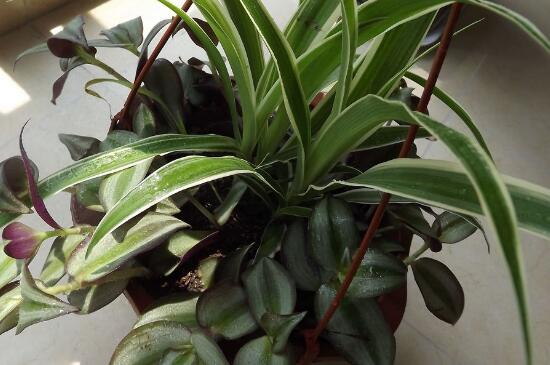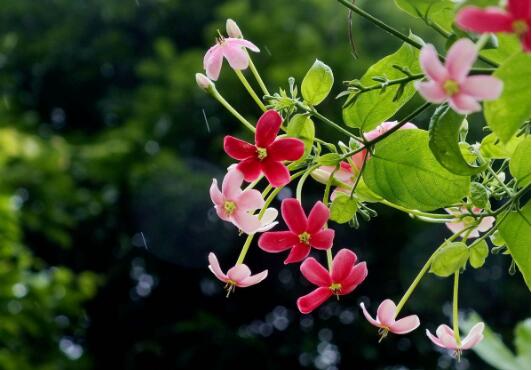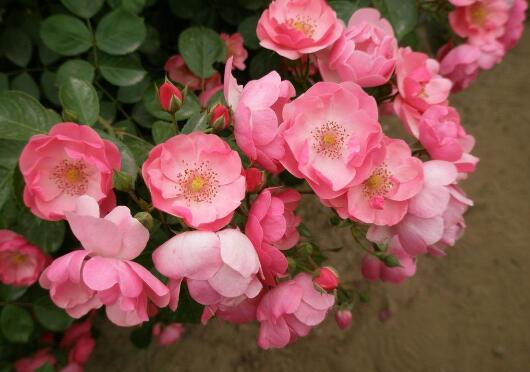What if Phnom Penh Cymbidium grows insects? disease and pest control of Phnom Penh Cymbidium / 3 insects and 2 diseases
As a kind of hanging orchid, Phnom Penh has inherited many advantages of its ancestors. It not only has strong adaptability and good growth, but also can absorb formaldehyde, which is the reason why flower friends keep it at home. However, in indoor farming, the plant inevitably grows sick for a variety of reasons. So, what should we do if Phnom Penh hanging orchids grow worms? The following is the pest control of several kinds of Phnom Penh orchids, follow the editor to have a look.
First, Phnom Penh hanging orchid long worm, spray with medicine

Although Phnom Penh orchids are not prone to diseases and insect pests, if they are not maintained according to the cultivation methods of Phnom Penh orchids, once there is stagnant water in the basin soil and poor ventilation, they will also suffer diseases and insect pests. As for the Phnom Penh hanging orchid worm how to do, in fact, it is very simple, indeed insect pests, and then aimed at spraying can be solved. The specific symptom is the method of prevention and treatment, and let's move on.
II. Pest control of Phnom Penh Cymbidium
1. Aphids
When it comes to Phnom Penh orchid worms, more than 80% are long aphids, which mainly harm leaves and buds, absorb a lot of juice, and lead to poor plant growth. Because aphids multiply, they are usually found densely packed, not only frightening, but also very disgusting.
Control method: find a small number of aphids, can take artificial control aphids, brush aphids with brush, buried in the basin soil. Aphids for a long time, the use of 40% of the concentration of imidophos diluted into 1000 times solution spray generally 7-10 days, continuous spraying 2-3 times can relieve the harm.
Other control methods: ① use 50 grams of fresh chili or dry red wine pepper, add 30 to 50 grams of water, boil for about half an hour, spray the parts attacked by aphids with its filtrate; ② washing powder 3-4 grams, add 100g water, stir into a solution, spray 2 to 3 times in a row, the control effect of aphids is excellent.
2. Scale insects
In the case of dense plant clusters and poor ventilation, Phnom Penh is vulnerable to scale insects, which will adsorb on the leaves and make the leaves lose their luster. Symptoms of damage: the leaf tip of Phnom Penh Cymbidium is dry, and the plant will die in severe cases.
Control method: first move the plant to a ventilated place, and then observe the disease. If there are few scale insects, you can wipe off the insects with laundry powder; when the disease and insect pests are long, you can spray with 1000 times the concentration of omethoate. You can also use 50% malathion diluted into 1500 solution for spray control.
3. Red spider
In addition to aphids and shell insects, red spider is also one of the diseases and insect pests of Phnom Penh, which mainly harms the leaves of the plant. After being attacked by red spiders, the diseased leaves of Phnom Penh showed small yellow and white spots at the initial stage, gradually turned red and extended to the whole leaf, and even caused the leaves to curl, wither and fall off.
Control methods: after the discovery of red spiders, 1500-2000 times trichloropropanol EC can be sprayed every 7 days, 2-3 times, and the effect is good.
4. Root rot
In the process of breeding, because of the stagnant water in the basin soil and poor ventilation, it will cause the roots of Phnom Penh to rot, thus causing the plant to suffer from root rot. Symptoms: root rot, leaves withered and yellow, until death.
Prevention and treatment methods: when the above symptoms are found, 50% carbendazim wettable powder can be sprayed 500 times, or it can be irrigated directly once a week; when the disease is serious, pull out Phnom Penh, remove its rotten roots, change soil and basin and replant.
5. Anthrax
One of the common diseases of Phnom Penh orchid mainly occurs under the conditions of high humidity and stifling heat, stagnant water in flowerpots, overdense plant clusters, poor ventilation and so on. Symptoms: the diseased leaves appear yellowish-brown and sunken spots, then expand called dark brown round spots, the leaf tip withered, and then the whole plant dies.
Prevention and treatment: cut off the diseased leaves and burn them centrally to reduce the source of the disease; in severe cases, spray 1000 times of carbendazim or 1000 times of methyl topiramate for antiseptic, which can be effective after 2-3 times.
What to do with the growth of peony orchid insects? pest control of peony orchid / 3 insects and 2 diseases
As a common indoor potted plant, the efficacy of peony orchid is very strong, it is not only good-looking, but also not vulnerable to diseases and insect pests, but also has good value in edible. But in indoor farming, for some reasons, peony orchid will inevitably be infected with disease and be disturbed by insects. So, what should I do if the peony orchid grows worms? Here are five kinds of peony pest control, let's go and have a look!
First, peony hanging orchid long worm, spray with medicine
The breeding method of peony orchid is not difficult, only need to pay a little attention to water and fertilizer, and give it enough light, it can grow very well. But in the breeding process, because of the basin soil stagnant water, poor ventilation and other conditions, it will suffer diseases and insect pests. As for the peony hanging orchid worm how to do, in fact, it is very simple, indeed insect pests, and then aimed at spraying can be solved.
II. Disease and pest control of peony orchid
1. Aphids
Indoor potted plant is the most common pest, which also endangers the health of peony orchid. The insect mainly harms leaves and buds and absorbs a lot of juice, resulting in poor plant growth. Because aphids multiply, they are usually found densely packed, not only frightening, but also very disgusting.
Prevention and control methods: if the number of aphids is very small, you can take artificial aphid control, brush off the aphids with a brush and bury them in the basin soil; if there are many aphids, you need to spray related agents, such as 1000 times of omethoate or 1000 times of dichlorvos, sprayed once every 10 days and sprayed for 3 times in a row.
2. Scale insects
In addition to aphids, in the case of dense plants and poor ventilation, peony orchids are also vulnerable to scale insects. The insect will attach to the leaves and make the leaves lose their luster, resulting in the yellowing of peony orchid leaves, and in severe cases, the whole plant will die.
Control method: move the plant to a ventilated place, cut off the diseased leaves to reduce the source of insects; then spray 40% omethoate diluted into 1000 times solution or 50% malathion diluted into 1500 solution for control.
3. Red spider
In addition, the red spider is also one of the peony hanging orchid diseases and insect pests, although it is very rare, but once the occurrence of great harm. It is understood that the insect mainly harms the leaves of the plant, causing small yellow and white spots on the leaves of the peony orchid, then gradually turning red and extending to the whole leaf, even causing the leaves to curl, wither and fall off.
Control methods: after the discovery of red spiders, 1500-2000 times trichloropropanol EC can be sprayed every 7 days, 2-3 times, and the effect is good.
4. Root rot
When it comes to peony orchid diseases and insect pests, the most common is root rot, which is mainly caused by stagnant water in basin soil and poor ventilation. Symptoms: root rot, leaves withered and yellow, until death.
Prevention and treatment methods: when the above diseases are found, 50% carbendazim wettable powder can be sprayed 500 times, or it can be irrigated directly once a week; when the disease is serious, pull out the peony orchid, remove its rotten roots, and change the soil and basin to replant.
5. Leaf blight
Under the conditions of high ambient temperature, high humidity and poor ventilation, peony orchid will also suffer from leaf blight. Disease symptoms: peony hanging orchid leaves first turn yellow, and then become brown disease spots, and finally spread to the whole plant.
Prevention and treatment method: when the above symptoms are found, 70% of the concentration of Dysen zinc is diluted into 600 times solution to spray for prevention and treatment, once every 15-20 days, 2-3 this can be effective.
Generally speaking, in the process of cultivating peony orchids, as long as we put it in a ventilated place and be careful not to pour too much water, it will not suffer from diseases and insect pests. Of course, do not be afraid to find that the peony orchid worm is sick, just solve it according to the above prevention and control methods. With regard to the pest control of peony hanging orchid, the editor has introduced this, hoping to bring help to everyone.
What to do with the growth of insects? disease and pest control of Cymbidium / 3 insects and 3 diseases
As the best of orchids, the efficacy of Magnolia is very powerful, it not only has the ability to absorb formaldehyde, but also more beautiful than ordinary orchids, but also has a good use in medicine. But in the process of breeding, many flower friends' plants will have the condition of growing insects and getting sick, so what about the growing insects of Cymbidium chinensis? In this regard, the editor summarized the prevention and control of six kinds of common diseases and insect pests, together to have a look.
First, the golden heart hanging orchid long worm, spray with medicine
Although the orchid is not prone to diseases and insect pests, if it is not maintained according to the cultivation method of the orchid, it is easy to have stagnant water in the basin soil, poor ventilation, rotten roots and so on, resulting in the plant still growing and getting sick. As for the golden orchid long worm how to do, in fact, it is very simple, indeed insect pests, and then aimed at spraying can be solved. The specific symptom is the method of prevention and treatment, and let's move on.
II. Prevention and control of diseases and insect pests of Cymbidium
1. Scale insects
Once the golden orchid worm is found, we can consider it to be a shell worm. Because the insect is prone to outbreak in a poorly ventilated environment, it will attach to the leaves and make the leaves lose their luster. Symptoms of damage: the leaves of Cymbidium are yellow, and the plant will die in severe cases.
Control methods: if there are relatively few scale insects, you can wipe off the insects with laundry powder; when the disease and insect pests are long, you can spray with 1000 times the concentration of omethoate, or you can use 50% malathion diluted into 1500 solution for spray control.
2. Aphids
One of the main pests of Cymbidium, it mainly harms leaves and buds, absorbs a lot of juice, resulting in poor plant growth. Because aphids multiply, they are usually found densely packed, not only frightening, but also very disgusting.
Prevention and control methods: a small number of aphids can be removed by rinsing with plant ash on the leaf surface; when aphids are frequent, 40% imidophos is diluted into 1000 times solution and sprayed once every 7-10 days, and the harm can be relieved by continuous spraying for 2-3 times.
3. Whitefly
One of the common pests that invade the orchid, it is small, propagates quickly, parasites on the phloem of the orchid, and absorbs its juice. Whitefly is generally difficult to detect, once it is found to be a large area, when the plant has been sucked away a large amount of juice, very weak.
Control method: once it is determined that it is whitefly, everyone should immediately use medicine to control it. It can be sprayed with 1000 times of imidathion EC or 1000 times of omethoate with a concentration of 40%. The best spraying time is in the early morning when the adult activity of whitefly is weak.
4. Root rot
In the process of breeding, because of the stagnant water in the basin soil and poor ventilation, it will cause the roots of the orchid to rot, thus causing the plant to suffer from root rot. Symptoms: root rot, leaves withered and yellow, until death.
Prevention and treatment methods: when the above symptoms are found, 50% carbendazim wettable powder can be sprayed 500 times, or it can be irrigated directly once a week; when the disease is serious, pull out Magnolia, remove its rotten roots, change soil and basin and replant.
5. Anthrax
One of the common diseases of Magnolia lanceolata mainly occurs under the conditions of high humidity and muggy environment, stagnant water in flowerpots, overdense plant clusters, poor ventilation and so on. Symptoms: the diseased leaves appear yellowish-brown and sunken spots, then expand called dark brown round spots, the leaf tip withered, and then the whole plant dies.
Prevention and treatment: cut off the diseased leaves and burn them centrally to reduce the source of the disease; in severe cases, spray 1000 times of carbendazim or 1000 times of methyl topiramate for antiseptic, which can be effective after 2-3 times.
6. Leaf blight
In the environment with high temperature, high humidity and poor ventilation, Cymbidium will also suffer from leaf blight. Symptoms: the leaves of Magnolia turn yellow at first, then become brown spots, and finally spread to the whole plant.
Prevention and treatment method: when the above symptoms are found, 70% of the concentration of Dysen zinc is diluted into 600 times solution to spray for prevention and treatment, once every 15-20 days, 2-3 this can be effective.
- Prev

What are the common diseases and insect pests of a gentleman? to make a gentleman's disease and insect pest control / 2 insect pests 3 diseases
In the process of making a gentleman's growth, the last thing we want to encounter is diseases and insect pests. This kind of problem is extremely harmful to the plant, and it will do great harm to the plant if it is not dealt with in time. So what are the common diseases and insect pests that make a gentleman? What do you need to do to make a gentleman's pest control?
- Next

What to do if the rattan rose grows worms? pest control of Fujimoto rose / 2 insect pests 2 diseases
In the growth process of Fujimoto rose, the last thing we want to encounter is diseases and insect pests, this kind of problem is very harmful to the plant, so we must deal with it in time when it is found. What about the growing worm of Fujimoto rose? What do you need to do to control diseases and insect pests of Fujimoto rose? Next, the editor will take you to learn about it.
Related
- Fuxing push coffee new agricultural production and marketing class: lack of small-scale processing plants
- Jujube rice field leisure farm deep ploughing Yilan for five years to create a space for organic food and play
- Nongyu Farm-A trial of organic papaya for brave women with advanced technology
- Four points for attention in the prevention and control of diseases and insect pests of edible fungi
- How to add nutrient solution to Edible Fungi
- Is there any good way to control edible fungus mites?
- Open Inoculation Technology of Edible Fungi
- Is there any clever way to use fertilizer for edible fungus in winter?
- What agents are used to kill the pathogens of edible fungi in the mushroom shed?
- Rapid drying of Edible Fungi

